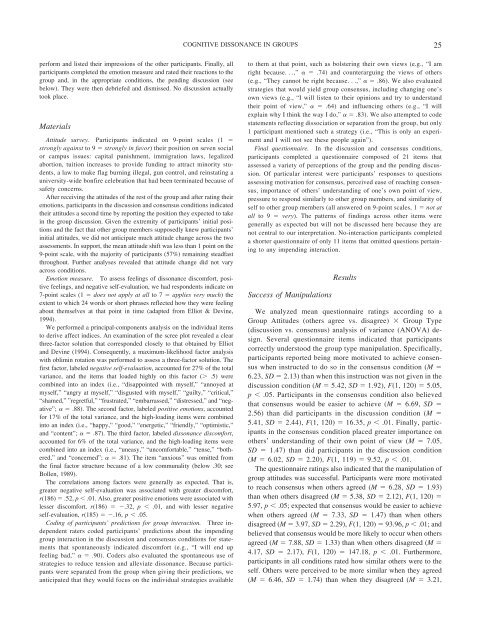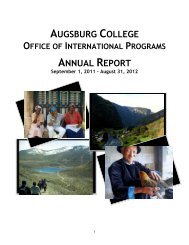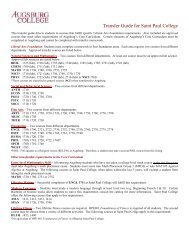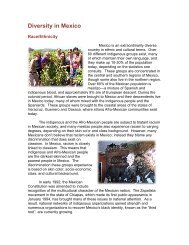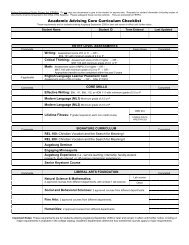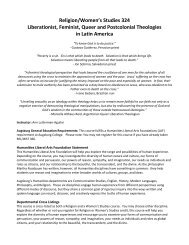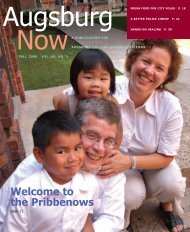Full Text PDF - American Psychological Association
Full Text PDF - American Psychological Association
Full Text PDF - American Psychological Association
- No tags were found...
Create successful ePaper yourself
Turn your PDF publications into a flip-book with our unique Google optimized e-Paper software.
COGNITIVE DISSONANCE IN GROUPS25perform and listed their impressions of the other participants. Finally, allparticipants completed the emotion measure and rated their reactions to thegroup and, in the appropriate conditions, the pending discussion (seebelow). They were then debriefed and dismissed. No discussion actuallytook place.MaterialsAttitude survey. Participants indicated on 9-point scales (1 strongly against to 9 strongly in favor) theirpositiononsevensocialor campus issues: capital punishment, immigration laws, legalizedabortion, tuition increases to provide funding to attract minority students,a law to make flag burning illegal, gun control, and reinstating auniversity-wide bonfire celebration that had been terminated because ofsafety concerns.After receiving the attitudes of the rest of the group and after rating theiremotions, participants in the discussion and consensus conditions indicatedtheir attitudes a second time by reporting the position they expected to takein the group discussion. Given the extremity of participants’ initial positionsand the fact that other group members supposedly knew participants’initial attitudes, we did not anticipate much attitude change across the twoassessments. In support, the mean attitude shift was less than 1 point on the9-point scale, with the majority of participants (57%) remaining steadfastthroughout. Further analyses revealed that attitude change did not varyacross conditions.Emotion measure. To assess feelings of dissonance discomfort, positivefeelings, and negative self-evaluation, we had respondents indicate on7-point scales (1 does not apply at all to 7 applies very much) theextent to which 24 words or short phrases reflected how they were feelingabout themselves at that point in time (adapted from Elliot & Devine,1994).We performed a principal-components analysis on the individual itemsto derive affect indices. An examination of the scree plot revealed a clearthree-factor solution that corresponded closely to that obtained by Elliotand Devine (1994). Consequently, a maximum-likelihood factor analysiswith oblimin rotation was performed to assess a three-factor solution. Thefirst factor, labeled negative self-evaluation, accounted for 27% of the totalvariance, and the items that loaded highly on this factor ( .5) werecombined into an index (i.e., “disappointed with myself,” “annoyed atmyself,” “angry at myself,” “disgusted with myself,” “guilty,” “critical,”“shamed,” ”regretful,” “frustrated,” “embarrassed,” “distressed,” and “negative”; .88). The second factor, labeled positive emotions, accountedfor 17% of the total variance, and the high-loading items were combinedinto an index (i.e., “happy,” “good,” “energetic,” “friendly,” “optimistic,”and “content”; .87). The third factor, labeled dissonance discomfort,accounted for 6% of the total variance, and the high-loading items werecombined into an index (i.e., “uneasy,” “uncomfortable,” “tense,” “bothered,”and “concerned”; .81). The item “anxious” was omitted fromthe final factor structure because of a low communality (below .30; seeBollen, 1989).The correlations among factors were generally as expected. That is,greater negative self-evaluation was associated with greater discomfort,r(186) .52, p .01. Also, greater positive emotions were associated withlesser discomfort, r(186) .32, p .01, and with lesser negativeself-evaluation, r(185) .16, p .05.Coding of participants’ predictions for group interaction. Three independentraters coded participants’ predictions about the impendinggroup interaction in the discussion and consensus conditions for statementsthat spontaneously indicated discomfort (e.g., “I will end upfeeling bad,” .90). Coders also evaluated the spontaneous use ofstrategies to reduce tension and alleviate dissonance. Because participantswere separated from the group when giving their predictions, weanticipated that they would focus on the individual strategies availableto them at that point, such as bolstering their own views (e.g., “I amright because. . .,” .74) and counterarguing the views of others(e.g., “They cannot be right because. . .,” .86). We also evaluatedstrategies that would yield group consensus, including changing one’sown views (e.g., “I will listen to their opinions and try to understandtheir point of view,” .64) and influencing others (e.g., “I willexplain why I think the way I do,” .83). We also attempted to codestatements reflecting dissociation or separation from the group, but only1participantmentionedsuchastrategy(i.e.,“Thisisonlyanexperimentand I will not see these people again”).Final questionnaire. In the discussion and consensus conditions,participants completed a questionnaire composed of 21 items thatassessed a variety of perceptions of the group and the pending discussion.Of particular interest were participants’ responses to questionsassessing motivation for consensus, perceived ease of reaching consensus,importance of others’ understanding of one’s own point of view,pressure to respond similarly to other group members, and similarity ofself to other group members (all answered on 9-point scales, 1 not atall to 9 very). The patterns of findings across other items weregenerally as expected but will not be discussed here because they arenot central to our interpretation. No-interaction participants completedashorterquestionnaireofonly11itemsthatomittedquestionspertainingto any impending interaction.Success of ManipulationsResultsWe analyzed mean questionnaire ratings according to aGroup Attitudes (others agree vs. disagree) Group Type(discussion vs. consensus) analysis of variance (ANOVA) design.Several questionnaire items indicated that participantscorrectly understood the group type manipulation. Specifically,participants reported being more motivated to achieve consensuswhen instructed to do so in the consensus condition (M 6.23, SD 2.13) than when this instruction was not given in thediscussion condition (M 5.42, SD 1.92), F(1, 120) 5.05,p .05. Participants in the consensus condition also believedthat consensus would be easier to achieve (M 6.69, SD 2.56) than did participants in the discussion condition (M 5.41, SD 2.44), F(1, 120) 16.35, p .01. Finally, participantsin the consensus condition placed greater importance onothers’ understanding of their own point of view (M 7.05,SD 1.47) than did participants in the discussion condition(M 6.02, SD 2.20), F(1, 119) 9.52, p .01.The questionnaire ratings also indicated that the manipulation ofgroup attitudes was successful. Participants were more motivatedto reach consensus when others agreed (M 6.28, SD 1.93)than when others disagreed (M 5.38, SD 2.12), F(1, 120) 5.97, p .05; expected that consensus would be easier to achievewhen others agreed (M 7.33, SD 1.47) than when othersdisagreed (M 3.97, SD 2.29), F(1, 120) 93.96, p .01; andbelieved that consensus would be more likely to occur when othersagreed (M 7.88, SD 1.33) than when others disagreed (M 4.17, SD 2.17), F(1, 120) 147.18, p .01. Furthermore,participants in all conditions rated how similar others were to theself. Others were perceived to be more similar when they agreed(M 6.46, SD 1.74) than when they disagreed (M 3.21,


